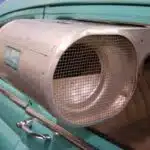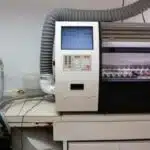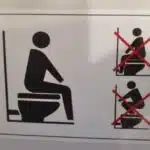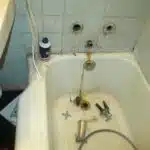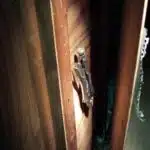Garbage disposals are a convenient appliance in any kitchen, but they can be frustrating when they stop working properly. Many homeowners experience issues such as clogs, leaks, and strange noises coming from their garbage disposals. Fortunately, most of these problems can be fixed without the need for professional assistance.
As a plumbing expert, I have encountered numerous cases of malfunctioning garbage disposals. In this article, I will provide you with solutions to common problems that arise with garbage disposals. By following the tips and techniques outlined in this article, you will be able to fix your garbage disposal quickly and easily, saving you time and money in the long run.
Identifying The Problem
Imagine hearing the sound of grinding metal coming from your sink as you attempt to dispose of food scraps. With each passing moment, the smell grows worse and the sink remains clogged. A malfunctioning garbage disposal can be a frustrating experience, but identifying the problem is the first step towards finding a solution.
Common causes of garbage disposal problems include jamming, clogging, and leaks. Jamming occurs when foreign objects such as utensils or bones become stuck in the blades, while clogging happens when food scraps accumulate within the disposal. Leaks often occur due to damaged pipes or worn out seals. Understanding these common issues can help pinpoint the problem with your garbage disposal.
Visual inspection is an important part of identifying the issue with your garbage disposal. Turn off all power sources and then use a flashlight to inspect inside the disposal for any visible blockages or damage. Check beneath your sink for leaks or drips that may indicate an issue with pipes or connections. By taking these steps, you can determine if further action is required to fix your malfunctioning garbage disposal.
By conducting a visual inspection and understanding common causes of garbage disposal problems, you can identify what may be causing issues with your own unit. The next step is checking for power to ensure no electrical issues are present before attempting any repairs.
Checking For Power
After identifying the problem with your garbage disposal, the next step is to check for power. Before attempting to fix anything, it is crucial to ensure that power is being supplied to the unit. The most common reasons for a disposal not turning on are a tripped circuit breaker or a faulty outlet.
To test the outlet, you should first unplug the disposal and plug in another appliance, such as a lamp or phone charger. If the other device does not work in the outlet, then it is likely that there is an issue with the electrical supply and you should call an electrician. If the other device does work, then plug in your disposal again and see if it turns on.
If your disposal still doesn’t turn on after checking the outlet, then you may need to reset the circuit breaker. Go to your home’s electrical panel and locate the breaker labeled for your kitchen or garbage disposal. Flip it off and then back on again. This will reset any tripped breakers and hopefully restore power to your disposal.
- Remember to always turn off power before working on a garbage disposal.
- Use caution when resetting breakers and dealing with electrical components.
- Inspect all cords leading to your garbage disposal for signs of damage.
- Consider calling an electrician if you suspect any issues with your home’s electrical supply.
Now that you’ve checked for power and restored electricity to your garbage disposal if necessary, it’s time to move onto clearing clogs.
Clearing Clogs
As the saying goes, “out of sight, out of mind.” Unfortunately, when it comes to a garbage disposal, this can lead to a buildup of food particles and debris that can cause clogs. Common causes for clogs include putting fibrous or starchy foods down the disposal and not running enough water during and after use. These clogs can be frustrating to deal with, but fortunately there are DIY solutions that can alleviate the problem.
One effective method is to use a plunger to create suction and dislodge any blockages. Simply fill the sink with enough water to cover the rubber part of the plunger and place it over the drain opening. Pump up and down several times until you feel resistance, then release. Repeat as necessary until the water begins to drain freely. Another method involves using a combination of baking soda and vinegar to break up any clogs. Pour ½ cup of baking soda down the drain followed by 1 cup of vinegar. Cover with a plug or cloth for 10-15 minutes before flushing with hot water.
Preventative maintenance is key in avoiding future clogs. Best practices include running cold water for at least 30 seconds before and after use, cutting large items into smaller pieces before putting them down the disposal, and avoiding putting non-food items down altogether. Regular cleaning with ice cubes and citrus peels can also help keep your garbage disposal in top shape.
With these common causes and DIY solutions in mind, clearing clogs should no longer be a daunting task for homeowners. The next step in maintaining your garbage disposal is removing objects that may accidentally fall inside – read on for more information on how to do so safely and effectively.
Removing Objects
To prevent blockages in your garbage disposal, it’s essential to be mindful of what you’re putting down the drain. Avoid disposing of hard objects such as bones, fruit pits, or shells that can damage the disposal blades and clog the drain. Additionally, avoid pouring fats, oils, and grease down the drain as they can solidify and cause blockages over time.
However, accidents happen, and you may find yourself in a situation where you need to retrieve an object from your garbage disposal. Before attempting to retrieve an object, make sure to turn off the power source to the unit. You can then use pliers or tongs to carefully remove any objects that are visible without causing further damage to the unit. If an object is not visible or is lodged deep within the disposal system, it’s best to call a professional plumber for assistance.
Retrieving objects from your garbage disposal and preventing blockages is essential for maintaining a functional appliance. However, if you notice leaks coming from your unit during operation or when not in use, it may be time to address potential issues with your plumbing system. In the next section, we’ll discuss how to fix leaks in your garbage disposal system and ensure proper functioning for years to come.
Fixing Leaks
Leaks are a common problem with garbage disposals, but fortunately, they can be fixed quite easily. Common causes of leaks include loose or damaged connections, worn-out gaskets, and cracks in the disposal itself. To prevent leaks from occurring in the first place, it is crucial to properly install and maintain your garbage disposal.
Loose or damaged connections are often the cause of leaks in garbage disposals. These can occur at the connection between the disposal and the sink drain or at any of the other connection points throughout the plumbing system. Prevention tips for this issue include tightening all connections during installation and regular maintenance checks to ensure that everything remains snugly connected.
Worn-out gaskets are another common cause of leaks in garbage disposals. Over time, these rubber seals can become brittle and cracked, allowing water to seep out around them. To prevent this issue from occurring prematurely, be sure to use a high-quality gasket when installing your disposal and avoid using harsh chemicals or abrasive materials that could damage it. If you do notice signs of wear on your gasket, replace it promptly to avoid further damage.
- Check all connections for tightness
- Replace worn-out gaskets promptly
- Avoid using harsh chemicals or abrasive materials on your disposal
- Schedule regular maintenance checks with a plumbing professional
With proper installation and maintenance practices, most leaks in garbage disposals can be avoided altogether. However, if you do experience a leak, don’t panic – it’s usually easy to fix with a few simple steps. In the next section, we’ll cover how to reset your disposal if it becomes jammed or stops working altogether.
Resetting The Disposal
If your garbage disposal stops working, it may be necessary to reset it. This is a common solution for many disposal problems and can often resolve the issue quickly. Common causes of disposal malfunctions include overuse, improper use, or simple wear and tear.
Before resetting your disposal, it is important to troubleshoot the problem. Check that the power switch is on, as well as any circuit breakers that may have tripped. If the disposal still does not work after these basic checks have been performed, then resetting it may be necessary.
To reset the disposal, locate the reset button on the bottom of the unit. Press this button firmly for about five seconds until you feel it click into place. Once you have done this, turn on the disposal and see if it begins to work properly again. If not, then there may be a more serious issue at hand that requires professional assistance.
Moving onto sharpening blades…
Sharpening The Blades
A common problem with garbage disposals is dull blades. This can result in a disposal that struggles to grind up food waste, causing backups and clogs in your pipes. One example of this is when a homeowner noticed their disposal was making a loud grinding noise and not disposing of the food waste properly. Upon inspection, they found that the blades were dull and needed sharpening.
Blade maintenance is an important aspect of keeping your garbage disposal running smoothly. There are two options for blade sharpening: DIY sharpening or professional blade sharpening. For those who prefer to do it themselves, DIY sharpening can be done using a metal file or sharpening stone. However, it’s important to note that improper sharpening can cause more harm than good. Professional blade sharpening may be more costly but has the benefit of ensuring proper sharpness and reducing the risk of damage to your disposal.
When considering blade maintenance, it’s important to weigh the cost and benefits of each option. DIY sharpening may save money in the short term, but if not done correctly can lead to further damage down the line. Professional blade sharpening may come at a higher cost but provides peace of mind and ensures maximum performance from your garbage disposal.
Moving forward with proper blade maintenance will keep your garbage disposal running efficiently for years to come. In the next section, we will discuss lubricating the motor to ensure optimal performance.
Lubricating The Motor
Lubricating the motor of a garbage disposal is an essential part of maintaining its functionality. Without proper lubrication, the motor can become difficult to turn, causing it to overheat and eventually fail. It is crucial to understand that maintenance is key to keeping your garbage disposal working efficiently.
When choosing a lubricant for your garbage disposal, it is important to choose one that is specifically designed for use with this type of appliance. Using the wrong lubricant can cause damage to the motor or even result in a fire hazard. There are several types of lubricants available on the market, including silicone-based and petroleum-based options. Silicone-based lubricants are generally preferred as they are non-toxic, odorless, and work well under high temperatures.
Regular maintenance should include lubricating the motor every few months. Begin by unplugging the unit before disconnecting it from the sink. Next, locate the access port on top of the unit and apply a few drops of your chosen lubricant. Afterward, turn on cold water while running the unit for 30 seconds to allow for an even distribution of oil throughout the motor’s bearings.
After performing regular maintenance tasks like lubricating the motor, you should also check other components such as the flywheel to ensure everything is in good working condition. Checking these components will help prevent any future problems with your garbage disposal and prolong its lifespan.
Checking The Flywheel
To ensure that your garbage disposal runs smoothly, it’s essential to check the flywheel. Flywheel maintenance is crucial because it’s responsible for grinding food waste and disposing of it with ease. If you notice any issues with your garbage disposal not working correctly, checking the flywheel should be a priority.
One of the most common troubleshooting techniques for checking the flywheel is to turn off the power supply and inspect the blades of the unit. Sometimes food debris or other foreign objects may get tangled in the blades, causing them to stop spinning. If you find any blockages, remove them carefully using pliers or tongs.
If there are no visible obstructions in the blades, try manually turning the flywheel by inserting an Allen wrench into its underside. If you can’t turn it easily, this indicates a more severe problem with your garbage disposal. In such cases, calling in a professional plumber is advisable as attempting to fix it on your own may result in further damage to your unit.
Moving on from checking the flywheel, if your garbage disposal is still not working even after fixing potential problems with it, you may need to address jammed disposals next. This issue requires more advanced troubleshooting techniques than simple flywheel maintenance and may require specialized tools or expertise for solving effectively.
Fixing Jammed Disposals
- Jammed disposals can be caused by numerous factors, including foreign objects that are too large for the disposal, food waste becoming trapped, or clogged drains.
- Unjamming a disposal can be accomplished by resetting the unit, or manually dislodging any obstructions with a plunger or a pair of tongs.
- To prevent disposals from becoming jammed, objects such as silverware, bones, eggshells, and fibrous materials should be avoided, and only small amounts of food waste should be disposed of at one time.
- Additionally, the disposal should be run on a regular basis to ensure that it is functioning properly.
- If the disposal appears to be jammed, it is recommended to turn off the power and disconnect the unit before attempting to unclog it.
- When disposing of any objects, it is important to consult the manufacturer’s manual to ensure that the disposal is being used correctly.
Identifying Causes
When it comes to fixing a jammed garbage disposal, the first step is identifying the cause of the problem. There are several common issues that can cause a garbage disposal to become jammed, including clogs, worn out blades or bearings, and electrical issues. Troubleshooting tips for identifying the cause of a jam include listening for unusual sounds when turning on the disposal and checking for any visible blockages.
One of the most common causes of a jammed garbage disposal is a clog in the drain line. This can be caused by putting inappropriate items down the drain, such as fibrous vegetables or grease. If this is suspected to be the issue, turn off power to the unit and use pliers or tongs to remove any visible debris from the drain line. Another potential cause could be worn out blades or bearings which can result in ineffective grinding and eventually lead to jams.
Lastly, electrical issues could also be responsible for causing your garbage disposal to jam. Before attempting any repairs that require electrical work, ensure that you have turned off power at the circuit breaker first. If you suspect an electrical problem but aren’t experienced with wiring repairs, it’s best to call in a licensed electrician who can diagnose and fix any underlying problems safely and efficiently. By following these troubleshooting tips for identifying causes of a jammed garbage disposal, you’ll be better equipped to keep your unit running smoothly and prevent future issues from arising.
Unjamming
When a garbage disposal gets jammed, it can be frustrating and even dangerous to try to fix it without proper knowledge. Unjamming a garbage disposal requires a different set of troubleshooting tips compared to identifying the cause of the problem. Common causes of jams include overloading the unit, using inappropriate items in the disposal, and lack of maintenance.
To unjam a garbage disposal, start by turning off power to the unit. Then, use a flashlight to look down the drain and locate any visible debris that may be causing the jam. If you see anything, use pliers or tongs to remove it carefully. Next, insert an Allen wrench or hex key into the bottom center of the unit and turn back and forth until it loosens up. Finally, turn on power to the unit and run water while running the disposal to check if it’s working properly.
Maintenance tips for preventing future jams include grinding ice cubes once a month to clean blades and prevent buildup, avoiding putting fibrous vegetables or grease down the drain, and using cold water when running your disposal. By following these simple steps for unjamming your garbage disposal and maintaining it regularly, you’ll ensure that your unit stays in good working condition for years to come.
Preventative Measures
Jammed garbage disposals are not only frustrating, but they can also be dangerous to fix without proper knowledge. While unjamming a disposal is crucial, it’s equally important to take preventative measures to avoid future jams. Regular maintenance and DIY cleaning can go a long way in keeping your garbage disposal working properly.
One effective way to maintain your garbage disposal is by grinding ice cubes once a month. The ice helps clean the blades and prevent any buildup that may cause clogs or jams. Additionally, avoiding putting fibrous vegetables or grease down the drain can significantly reduce the likelihood of jams occurring. Instead, consider composting vegetable scraps and disposing of grease in a separate container.
Using cold water when running your disposal is another simple yet effective maintenance tip for preventing future jams. Cold water solidifies any grease or fat that may have accumulated in the unit, making it easier for the blades to grind it up and flush it out. By following these preventative measures regularly, you’ll ensure that your garbage disposal stays in good working condition for years to come while avoiding costly repairs or replacements down the line.
Repairing Faulty Wiring
After fixing jammed disposals, the next issue one might encounter with their garbage disposal is faulty wiring. Faulty wiring can lead to a variety of problems, including the disposal not turning on or not working properly. If you suspect your garbage disposal has faulty wiring, it’s important to address the issue promptly to ensure there are no safety hazards.
Replacing the switch may be a necessary step in repairing faulty wiring. To do this, first turn off power to the disposal by unplugging it or turning off the circuit breaker. Then, remove the switch cover plate and disconnect the wires from the old switch. Connect these wires to the new switch and secure it in place by screwing on the cover plate. Turn on power to test if this fixed the problem.
If replacing the switch does not solve your problem, testing continuity may be required. Continuity testing involves checking for breaks in electrical currents between two points in a circuit. This should only be done by someone with experience or training in electrical work as it can be dangerous if done incorrectly. If continuity testing reveals an issue, consult a professional plumber or electrician for further assistance.
Moving onto replacing the disposal itself, there are several steps involved in this process that require careful attention and knowledge of plumbing systems. Before attempting this task yourself, consider consulting with a professional plumber who can guide you through each step and ensure proper installation of your new garbage disposal unit.
Replacing The Disposal
When all else fails, it may be time to replace your garbage disposal. A disposal installation is a relatively simple task that can be completed in just a few hours. Before beginning the process, gather all necessary tools and equipment, including a new disposal unit, plumber’s putty, and mounting hardware.
First, shut off power to the disposal by unplugging it or turning off the circuit breaker. Next, remove the old unit by disconnecting it from the mounting assembly under the sink and detaching any remaining plumbing connections. Use a putty knife to scrape away any old plumber’s putty or debris from around the mounting assembly.
With the old unit removed, it’s time to install the new one. Follow manufacturer instructions carefully to ensure proper installation and use of your upgraded disposal technology. Once installed, test for leaks and proper operation before returning any items stored under your sink.
- Important considerations during disposal installation:
- Ensure adequate space under your sink for new unit
- Take measurements before purchasing new unit
- Adjust plumbing connections as needed
- Consider upgrading to a higher horsepower model for improved performance
- Consult with a professional for recommendations on best fit for your needs
By replacing your old garbage disposal with an upgraded model, you can enjoy improved functionality and performance in your kitchen. With proper installation and maintenance, you can prevent future issues and keep your kitchen running smoothly.
Preventing Future Issues
Regular maintenance of a garbage disposal should include a monthly check to ensure all parts are functioning properly. Additionally, it is important to check the plumbing connections to ensure they are secure and free of any debris or clogs. To prevent any future issues, it is recommended to run cold water and grind ice cubes through the disposal on a regular basis. Finally, it is important to make sure that only appropriate items are placed in the disposal and to avoid overloading it.
Regular Maintenance
The importance of maintenance cannot be overstated when it comes to keeping your garbage disposal in good condition. Regular maintenance not only prevents future issues but also extends its lifespan. With proper care and attention, you can avoid costly repairs and replacement down the line.
One of the most effective ways to maintain your garbage disposal is through DIY maintenance tips. A simple yet effective tip is to run cold water before, during, and after use. This helps flush out any food particles that may have accumulated in the disposal unit. Another handy tip is to grind lemon peels or ice cubes once a week to help clean and deodorize the unit.
Regular maintenance not only keeps your garbage disposal functioning optimally but also ensures safety for you and your family. Always remember to turn off the power source before working on your garbage disposal unit. If you are unsure how to perform DIY maintenance or encounter any issues with your disposal, it’s best to seek professional plumbing assistance. By taking these steps, you can prevent future issues and enjoy a smoothly functioning garbage disposal for years to come.
Check Plumbing Connections
Garbage disposals are an essential component of every modern kitchen, and they make meal preparation and cleanup much more convenient. However, over time, these units can experience issues that may cause them to malfunction or stop working altogether. One of the main reasons for this is loose or worn-out plumbing connections.
Inspecting seals and tightening bolts is a crucial aspect of maintaining your garbage disposal unit. The plumbing connections must be secure to prevent leaks, which can damage your cabinet, flooring, and other surrounding areas. Therefore, it’s essential to check the seals around the sink flange and ensure that the mounting assembly is tightly secured to the sink.
Checking plumbing connections should be part of your regular maintenance routine. It’s advisable to inspect them at least once a year or more frequently if you notice any signs of leakage or looseness. By doing so, you can prevent future issues that may lead to costly repairs or replacement. Remember that prevention is always better than cure when it comes to maintaining your garbage disposal unit.
Professional Assistance
Imagine you have tried all the DIY methods to fix your garbage disposal, yet it still doesn’t work. At this point, seeking professional assistance may be your best option. While DIY solutions can be cost-effective, they may not always be convenient or effective. Hiring a professional plumber can ensure that the problem is correctly diagnosed and resolved promptly.
When deciding whether to hire a professional plumber or attempt a DIY fix, cost factors versus convenience come into play. While hiring a plumber may be more expensive than attempting to fix the problem yourself, it will save you time and effort in the long run. A professional plumber has the necessary skills and experience to quickly diagnose and repair any issues with your garbage disposal.
Moreover, hiring a professional plumber ensures that safety precautions are taken during repairs. Professional plumbers have access to specialized tools and equipment that ensure safe working conditions while repairing garbage disposals. Attempting to fix the issue yourself without proper knowledge or equipment can lead to personal injury or damage to your home’s plumbing system.
Transitioning into the subsequent section about safety precautions when fixing a garbage disposal, it is essential always to prioritize safety when dealing with plumbing issues in your home. Although seeking professional help is recommended, there are ways to ensure safety when attempting DIY fixes at home.
Safety Precautions
When working with a garbage disposal, safety should be the primary concern. Failure to take adequate safety measures can result in injury or damage to the equipment. Therefore, it is essential to follow safety precautions when fixing a garbage disposal.
First and foremost, you need to wear safety gear when fixing a garbage disposal. This may include gloves, goggles, and ear protection. Gloves will protect your hands from sharp blades and other debris in the unit. Goggles will protect your eyes from flying debris or chemicals that may splash during the repair process. Ear protection is also necessary because working on a garbage disposal often involves loud noise levels.
Another significant hazard to consider is electrical hazards when fixing a garbage disposal. To avoid electrical shock, make sure that you turn off the power supply before attempting any repairs on the unit. You can do this by unplugging the unit or turning off the circuit breaker that supplies power to it.
Moreover, always maintain a safe distance from the blades of a garbage disposal while it’s running. Never put your hand inside the unit while it’s turned on or attempt to remove an object lodged in it with your fingers. Instead, use pliers or tongs to retrieve items that are stuck in the unit.
Overall, taking adequate safety precautions when fixing a garbage disposal is crucial for avoiding injury and ensuring that repairs are done correctly. By following these guidelines and using appropriate safety gear, you can safely fix any problems with your garbage disposal without putting yourself or others at risk.
Conclusion
Garbage disposals are essential appliances in any kitchen, but they can also be a source of frustration when they malfunction. As a plumbing expert, it is important to know how to identify and fix the problems that arise with these machines. By following the steps outlined in this article, you can troubleshoot issues with your garbage disposal and get it back up and running smoothly.
One metaphor that can help illustrate the importance of maintaining your garbage disposal is comparing it to a car engine. Just as neglecting routine maintenance on your car can lead to breakdowns and costly repairs, failing to properly care for your garbage disposal can result in clogs, leaks, or even complete failure. Regularly checking for power, clearing clogs, removing foreign objects, fixing leaks, and replacing the disposal when necessary are all crucial steps in keeping your machine running smoothly.
In conclusion, knowing how to fix a garbage disposal requires identifying common problems and implementing solutions like clearing clogs or fixing leaks. Maintaining your appliance takes time and effort but avoiding future issues is well worth it. Remember to take safety precautions before attempting repairs or professional assistance may be required. With proper care and attention to detail, you’ll have no problem keeping your garbage disposal functioning efficiently for years to come.
Image Credits
- “Garbage Disposal” by Mike Burns (featured)

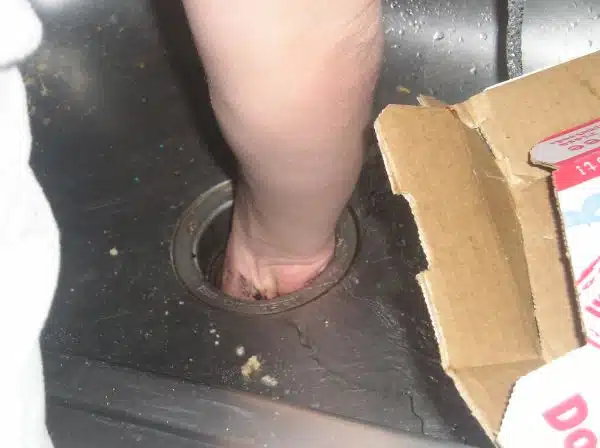
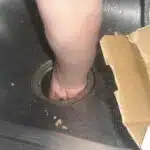
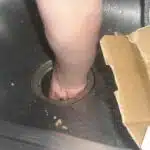

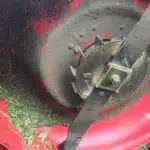


![How To Get Hair Out Of A Bathtub Drain 8 2/365 [Bathtub Drain]](https://green-life.blog/wp-content/uploads/2023/05/cOEu5edpkejq-150x150.jpg.webp)



